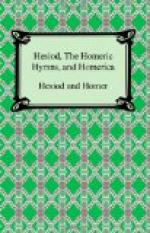either contemporary or slightly earlier than Lesches.
(15) Cp. Allen and Sikes, “Homeric Hymns” p. xv. In the text I
have followed the arrangement of these scholars, numbering
the Hymns to Dionysus and to Demeter, I and ii respectively:
to place “Demeter” after “Hermes”, and the Hymn to Dionysus
at the end of the collection seems to be merely perverse.
(16) “Greek Melic Poets”, p. 165.
(17) This monument was returned to Greece in the 1980’s. — DBK.
(18) Cp. Marckscheffel, “Hesiodi fragmenta”, p. 35. The papyrus
fragment recovered by Petrie ("Petrie Papyri”, ed. Mahaffy,
p. 70, No. xxv.) agrees essentially with the extant
document, but differs in numerous minor textual points.
BIBLIOGRAPHY
Hesiod. — The classification and numerations of MSS. here followed is that of Rzach (1913). It is only necessary to add that on the whole the recovery of Hesiodic papyri goes to confirm the authority of the mediaeval MSS. At the same time these fragments have produced much that is interesting and valuable, such as the new lines, “Works and Days” 169 a-d, and the improved readings ib. 278, “Theogony” 91, 93. Our chief gains from papyri are the numerous and excellent fragments of the Catalogues which have been recovered.
“Works and Days”: —
S Oxyrhynchus Papyri 1090.
A Vienna, Rainer Papyri L.P. 21-9 (4th cent.).
B Geneva, Naville Papyri Pap. 94 (6th cent.).
C Paris, Bibl. Nat. 2771 (11th cent.).
D Florence, Laur. xxxi 39 (12th cent.).
E Messina, Univ. Lib. Preexistens 11
(12th-13th cent.).
F Rome, Vatican 38 (14th cent.).
G Venice, Marc. ix 6 (14th cent.).
H Florence, Laur. xxxi 37 (14th cent.).
I Florence, Laur. xxxii 16 (13th cent.).
K Florence, Laur. xxxii 2 (14th cent.).
L Milan, Ambros. G 32 sup. (14th cent.).
M Florence, Bibl. Riccardiana 71 (15th cent.).
N Milan, Ambros. J 15 sup. (15th cent.).
O Paris, Bibl. Nat. 2773 (14th cent.).
P Cambridge, Trinity College (Gale Ms.), O.9.27
(13th-14th
cent.).
Q Rome, Vatican 1332 (14th cent.).
These MSS. are divided by Rzach into the following families, issuing from a common original: —
Omegaa = C Omegab = F,G,H Psia = D Psib = I,K,L,M Phia = E Phib = N,O,P,Q
“Theogony”: —
N Manchester, Rylands Gk. Papyri No.
54 (1st cent. B.C. — 1st
cent. A.D.).
O Oxyrhynchus Papyri 873 (3rd cent.).
A Paris, Bibl. Nat. Suppl. Graec.
(papyrus) 1099 (4th-5th
cent.).
B London, British Museam clix (4th cent.).
R Vienna, Rainer Papyri L.P. 21-9 (4th cent.).
C Paris, Bibl. Nat. Suppl. Graec.
663 (12th cent.).
D Florence, Laur. xxxii 16 (13th cent.).
E Florence, Laur., Conv. suppr. 158 (14th cent.).
F Paris, Bibl. Nat. 2833 (15th cent.).
G Rome, Vatican 915 (14th cent.).
H Paris, Bibl. Nat. 2772 (14th cent.).
I Florence, Laur. xxxi 32 (15th cent.).
K Venice, Marc. ix 6 (15th cent.).
L Paris, Bibl. Nat. 2708 (15th cent.).




